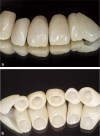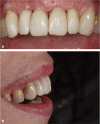Digital work-flow
- PMID: 25694797
- PMCID: PMC4302742
Digital work-flow
Abstract
Objective: The project presents a clinical case in which the digital work-flow procedure was applied for a prosthetic rehabilitation in natural teeth and implants.
Materials: Digital work-flow uses patient's photo for the aesthetic's planning, digital smile technology for the simulation of the final restoration and real time scanning to register the two arches. Than the scanning are sent to the laboratory that proceed with CAD-CAM production.
Results: Digital work-flow offers the opportunities to easily speak with laboratory and patients, gives better clinical results and demonstrated to be a less invasiveness method for the patient.
Conclusion: Intra-oral scanner, digital smile design, preview using digital wax-up, CAD-CAM production, are new predictable opportunities for prosthetic team. This work-flow, compared with traditional methods, is faster, more precise and predictable.
Keywords: CAD-CAM; digital scanner; digital smile; digital wax-up; digital work-flow.
Figures








References
-
- Rubel BS. Impression materials: a comparative review of impression materials most commonly used in restorative dentistry. Dent Clin North Am. 2007 Jul;51(3):629–42. vi. Review. - PubMed
-
- Johnson GH, Craig RG. Accuracy of four types of rubber impression materials compared with time of pour and a repeat pour of models. J Prosthet Dent. 1985 Apr;53(4):484–90. - PubMed
-
- Millstein PL. Determining the accuracy of gypsum casts made from type IV dental stone. Source J Oral Rehabil. 1992 May;19(3):239–43. Department of Biomaterials, Boston University, Goldman School of Graduate Dentistry, Massachusetts 02118. - PubMed
-
- Christensen GJ. The challenge to conventional impressions. J Am Dent Assoc. 2008 Mar;139(3):347–9. No abstract available. - PubMed
Publication types
LinkOut - more resources
Full Text Sources
Miscellaneous
